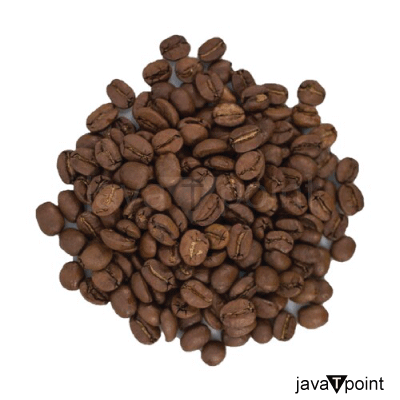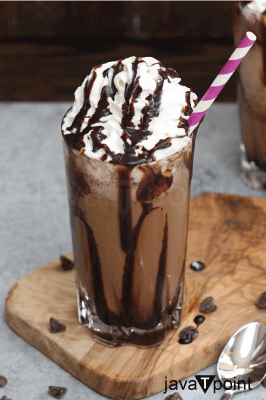Mocha JavaIn the realm of exclusivity, Mocha Java is the oldest and most famous and enduring coffee blend or coffee bean blend. This particular mix, which combines the tastes of Ethiopian Java and Arabian Mocha coffee beans, has enchanted coffee lovers for generations with its exquisite and harmonious flavor profile. The historic port city of Al-Makha in Yemen is where the word "Mocha" originated. Al-Makha was famous for exporting precious Arabian Mocha beans. The name "Java" refers to the verdant Indonesian island where Java beans are grown. Mocha Java coffee is a representation of the long-standing tradition and skill of coffee blending due to its rich history, well-balanced flavor, and cultural value. 
Characteristics of a Mocha Java
Steps Involved in Making a Mocha Java CoffeeThe tea base and the mocha-flavored addition are two separate ingredients that are combined to create a mocha java tea/ coffee. The specific steps to make a delicious cup of Mocha Java Tea are as follows: Step 1: Gather Ingredients and Equipment Make sure you have all the tools and ingredients ready. Black tea leaves (Assam or Ceylon tea works well), cocoa powder, milk or a milk substitute (such as almond milk), sweetener of choice (sugar, honey, or agave syrup), and water are required to make mocha java tea. A pot, a stirring spoon, and a tea infuser or tea bag are also required. Step 2: Brew the Black Tea Bring water to a boil in a saucepan to begin. Black tea leaves should be measured out appropriately (usually one teaspoon per cup) and added to the tea bag or infuser. The tea should steep for the specified amount of time, often 3-5 minutes, after being poured over the boiling water. To get the tea strength you desire, adjust the steeping time. Step 3: Creating the Mocha Flavored Mix Make the mocha-flavored mix while the tea is steeping. Create a smooth paste by combining cocoa powder and a little boiling water in a different container. This guarantees optimal cocoa powder dissolution in the tea and avoids the formation of lumps. Step 4: Combine Tea and Mocha Mix After the tea has finished steeping, remove the tea infuser or tea bag and throw away the discarded leaves. Fill your preferred tea cup with freshly brewed black tea, leaving room for the milk and mocha mix. Step 5: Add Mocha Mix and Milk The next step is adding the prepared mocha-flavored mix and milk to the brewed tea in the cup. To fully melt the tea and cocoa flavors, thoroughly stir the mixture. Pour the milk or milk substitute after that, according to your taste and creaminess. To make sure the ingredients are thoroughly mixed, stir again. Step 6: Sweeten to Taste Add the sweetener of your choice to the Mocha Java Tea based on your preferences. Start with a tiny quantity, taste it, and make adjustments until you reach the ideal sweetness. Stir the sweetener thoroughly until it dissolves. Step 7: Extra Garnishes You can also add extra garnishes to your Mocha Java Tea to improve the presentation and flavor. The flavor is elevated and given depth with a garnish of cocoa powder or chocolate shavings; some Oreo enthusiasts also add crushed Oreos in replacement to cocoa powder. Additionally, you may use a frother to make milk foam and give your Mocha Java Tea a velvety finish if you want a frothy texture. Step 8: Enjoy Your Mocha Java Tea Your handmade mocha java tea is ready to be enjoyed once you have finished all the stages. Enjoy a cup of the delicious concoction of sweetened milk, rich black tea, and cocoa flavor. The best of tea and chocolate are combined in Mocha Java Tea, a soothing and gratifying beverage that is a pleasure for the senses and the ideal companion for cuddly moments and coffee-inspired indulgence. 
History of Mocha Java CoffeeYemen has a unique place in the history of coffee production. It is thought that coffee originated in Ethiopia and was brought to Yemen by Sufi monks. The monks frequently utilized coffee's caffeine as a stimulant to help them concentrate during religious ceremonies. Yemen had a large coffee farming population by the 15th century, and trade was thriving there. As a result, the Mocha coffee bean as we know it today was born. Al-Mukh, the port in Mocha where coffee was exported, inspired the name (i.e., Mocha) of the beans. On the other hand, in the 1600s, the Dutch brought coffee to Indonesia. On the island of Java, the first coffee plantations were developed, and it is because of this that Java and coffee have become synonymous. Indonesia saw rapid growth as one of the world's major producers of coffee thanks to its thriving coffee industry. Yemen's supremacy in the trade market quickly diminished as a result of Indonesian coffee's commercialization. In contrast to Indonesia's 773,409 tonnes of production, Yemen was reported to have produced around 22,383 tonnes of coffee in 2020. Trade ships traveling between Europe and Indonesia frequently anchored in the ports of Mocha and Java. Coffee was put onto transport vessels to meet demand as the commodity became more and more popular in Europe. The Mocha Java blend was created when Java and Mocha beans were accidentally combined, whether on purpose or by mistake. The hefty body of Indonesian Java and the fruity acidity of Yemen Mocha complement each other excellently, leading to the common belief that the beans were blended for flavor. What makes Java and Mocha different from one another?The terms "Java" and "Mocha" relate to two different geographic regions and their corresponding coffee beans. Java, an Indonesian island, is well-known for its robust, full-bodied coffee that has overtones of herbs and the earth. On the other hand, Mocha, a port city in Yemen, is well-known for its coffee beans, which have an exceptional bittersweet chocolate flavor with fruity overtones. The Mocha Java blend produces a well-rounded and nuanced coffee flavor, which blends beans from both Java and Mocha regions. How does Mocha coffee taste?A distinctive flavor profile of mocha coffee includes notes of bittersweet chocolate, fruity undertones, and a tinge of earthiness. Instead of adding chocolate to the coffee, the natural characteristics of the mocha beans are what gives the coffee its chocolate flavor. The name "Mocha" relates to the Yemeni port from which these beans are sourced. What does Java coffee taste like?Java coffee is renowned for its robust flavor, high body, low acidity, and syrupy consistency. Typically, the beans exhibit herbal, earthy, and occasionally spicy flavors. Java coffee's flavor might vary depending on the location of the island and the processing techniques utilized, but a rich, robust profile typically distinguishes it. Roasting Mocha Java Coffee BeansNumerous distinct factors influence the coffee roasting process. These include both internal characteristics of the green bean and exterior elements like the surrounding temperature. There are two methods for roasting coffee mixtures. Before combining, the ingredients might be individually roasted, a process known as post-blending. As an alternative, pre-blending involves roasting all the ingredients simultaneously. It is vital to remember that the Yemen Mocha's roast level may significantly affect the cup's properties. Yemen Mocha is typically used between 25% and 50% in blends, with the ratio rising with darker roasts and falling with lighter ones. Adequate packaging is crucial for maintaining the qualities and freshness of Mocha Java. The pace at which carbon dioxide (CO2) is released from roasted beans varies, which is critical for coffee blends. As a roaster, you can ensure a great experience for your customers by investing in high-quality packaging and having a thorough understanding of the coffee you work with. When roasting Mocha Java coffee beans, roasters need to ensure that the flavor remains consistent and accurately retained through the final cup. ConclusionOverall, Mocha Java coffee demonstrates a variety of qualities that make it a beloved and adaptable coffee blend. From its balanced flavors and medium-dark roast to its ethical sourcing and artisanal production, Mocha Java satisfies the senses and introduces coffee lovers to the beverage's exciting past and ongoing allure. For those looking for a sophisticated and satisfying coffee experience, Mocha Java continues to be a popular option.
Next TopicTrident Java Fern
|
 For Videos Join Our Youtube Channel: Join Now
For Videos Join Our Youtube Channel: Join Now
Feedback
- Send your Feedback to [email protected]
Help Others, Please Share










